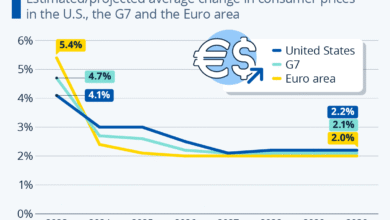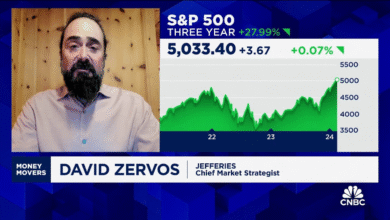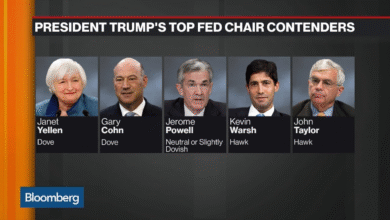U.S. Payroll Increase: Job Growth Surpasses Expectations

The recent U.S. payroll increase of 147,000 in June has sparked significant interest among analysts, as this figure not only exceeded expectations but also highlighted the ongoing strength of the labor market. In the latest labor market report, nonfarm payrolls showed impressive growth, surpassing estimates and indicating a thriving job landscape. The rise has prompted discussions on job growth, particularly against the backdrop of a declining unemployment rate, which fell to its lowest since February at 4.1%. This trend raises questions about the current interest rate forecast as market dynamics adjust in reaction to the payroll jobs increase. As various sectors like government and healthcare continue to flourish, the implications for the overall economy are profound, signaling robust employment trends worth monitoring closely.
In June, the increase in U.S. employment figures paints a vivid picture of a thriving job market that defied expectations across various sectors. This surge in job numbers reflects substantial gains in areas like government employment, paving the way for economic growth amid fluctuating economic conditions. Notably, the labor sector witnessed notable activities that not only bolstered job opportunities but also influenced the unemployment metrics positively. As predictions concerning interest rates evolve, it is evident that the recent payroll gains have injected renewed confidence in economic prospects. Observations of labor trends, including shifts in hiring patterns and emerging opportunities, will be crucial for stakeholders tracking market developments closely.
Understanding U.S. Payroll Increase Amidst Job Growth in June 2023
The U.S. payroll increase of 147,000 jobs in June 2023 paints a rosy picture of the labor market’s resilience, especially as it exceeded forecasts significantly. This impressive growth in nonfarm payrolls—up from an adjusted count of 144,000 in May—implies that contrary to earlier expectations, companies are still hiring amid economic uncertainty. Notably, strong government job growth, particularly in public education sectors, accounted for a majority of the increase, indicating targeted investment in crucial public services.
Furthermore, the payroll jobs increase not only reflects confidence among employers but also shifts market expectations dramatically. Following this substantial report, the probability of a mid-July interest rate cut plummeted, suggesting that the robust labor market is convincing market players of steady economic conditions. With an uptick in state and local government hiring, the overall job landscape appears stable, as sectors like healthcare and social assistance continue to thrive, counting for significant portions of new positions added.
Labor Market Report: Unemployment Rate Declines Significantly
June’s labor market report revealed a decline in the unemployment rate to 4.1%, highlighting a decrease that surpasses previous forecasts of a slight increase. This substantial drop indicates not just an improvement in job creation but also potential shifts in workforce dynamics, such as the aging workforce or individuals exiting the job-seeking pool. While this figure seems promising, it’s essential to analyze the broader labor market context to determine the sustainability of such positive trends.
The unemployment rate’s decrease primarily stems from fewer individuals seeking work, leading to a lower labor force participation rate, which now sits at 62.3%. Economists have raised concerns regarding this trend as it may not reflect an overall improvement in economic conditions. The fact that the number of discouraged workers has grown—indicating that many have given up on job searching—presents a nuanced picture of a labor market that may appear healthy on the surface but could be masking underlying challenges.
Exploring Job Growth Dynamics and Sector Performance
In June 2023, job growth highlighted a dichotomy across various sectors in the U.S. economy. While the healthcare industry added 39,000 jobs and the public sector saw a notable uptick, areas such as manufacturing reported losses. This divergence underscores the complexities in job creation and emphasizes the need for targeted economic policies. Growth in education and local government suggests a push towards strengthening public services after years of budget cuts.
However, as pointed out by economists, this job growth predominantly benefits certain sectors, raising concerns for those seeking employment in fields outside of healthcare and education. The loss of manufacturing jobs, coupled with a relatively stagnant landscape in other sectors, underscores the importance of diversification in job growth. Ultimately, understanding these dynamics will be essential for policymakers aiming to create a balanced and resilient labor market.
Interest Rate Forecast Post-Payrolls Report: Economic Implications
The payroll report has not only implications for the labor market but also for monetary policy moving forward. Following the report, market pricing indicated a significant decrease in expectations for a July interest rate cut, which dropped from 23.8% to just 4.7%. This adjustment highlights the correlation between strong payroll growth and monetary policy, wherein robust job creation diminishes the urgency for the Federal Reserve to lower interest rates, which have been steady between 4.25%-4.5%.
The interest rate forecast shows that now, rather than considering an immediate reduction, the market anticipates that any potential cuts may be postponed until September. This shift in expectations illustrates how employment data significantly influence monetary policy decisions, aligning closely with economic stability. Stakeholders are left to navigate this evolving landscape while keeping a close eye on inflationary pressures and the ongoing interplay between job growth and interest rate strategies.
Average Hourly Earnings Trends and Inflation Pressure
In conjunction with job growth, the average hourly earnings showed a slight increase of 0.2% for June and 3.7% year-on-year. This trend suggests that while wage growth is present, it remains moderate, contributing to a lack of substantial inflationary pressure in the economy. Such patterns in hourly earnings reflect the complexities within the labor market, indicating that even with job additions, wage growth has not escalated sharply in line with expectations.
This minimal upward pressure on wages is significant as it eases concerns over inflation among economists and market analysts. The sustained low inflation environment, despite increasing employment figures, provides a conducive setting for the Federal Reserve to maintain current interest rates without risking economic overheating. Indeed, a careful observation of wage trends may offer valuable insights into the overall health of the economy in the months to come.
Federal Employment Declines: What It Means for Public Sector Job Growth
Interestingly, while the overall job growth remained positive in June, federal employment saw a decline of 7,000 positions due to cuts from the Department of Government Efficiency. This trend raises critical questions regarding the future of public sector employment and its effects on overall job growth metrics. As government agencies adjust to budgetary constraints, the potential for reduced federal hiring could offset gains made in other areas.
The implications of these federal job losses extend beyond mere numbers; they could dramatically impact services and community programs that rely on government personnel. With state and local hiring on the rise, it remains to be seen how the dynamics between federal, state, and local employment will play out, particularly in a time when economic challenges may call for a more robust public workforce.
Household Survey Insights: The Bigger Picture of Employment
While the payroll report offers a comprehensive view of job growth, insights from the household survey further elucidate employment trends. The household survey indicated only a modest gain of 93,000 jobs, contrasting sharply with payroll figures. This discrepancy highlights an essential consideration: the household measure encompasses a broader range of employment changes, including those not captured by payroll data. It’s vital to analyze these figures holistically to gain a complete understanding of employment conditions.
Additionally, the increase of 329,000 individuals who are no longer counted in the labor force points to critical shifts in labor market dynamics. With many individuals stepping away from job searching altogether, the effectiveness of traditional measures such as the unemployment rate becomes unclear. This suggests the necessity for a revamped approach to understanding labor market health, focusing on inclusivity and catering to those in various employment circumstances.
Stock Market Reactions Post-June Employment Data
The stock market reacted positively to the strong June jobs report, with futures indicating confidence in continued economic growth. As the results unfolded, Treasury yields surged—a clear signal of investor optimism—reinforcing a narrative of stability in the labor market after diverse economic challenges. The alignment of job gains with the year-to-date average further solidifies perceptions of an economy on steady footing.
However, it’s crucial for investors and analysts to consider long-term implications. While a robust jobs report can lead to immediate market positivity, it should prompt scrutiny on the sustainability of such trends. Monitoring sector-specific performances, alongside broader economic indicators, will enable stakeholders to make informed decisions as they navigate through evolving market conditions.
Economic Resilience Amidst Challenges: Looking Ahead
This robust job growth, alongside a declining unemployment rate, shows a resilient U.S. labor market that has withstood recent economic challenges. However, economists urge caution, noting that this stability heavily relies on the healthcare, social assistance, and public sectors, which reaffirms the importance of industry diversity for sustainable economic support. Future job growth in other areas may prove elusive if these sectors do not expand efficiently.
Moving forward, understanding and addressing the challenges within the labor market will be essential for sustainable development. As businesses and policymakers navigate these waters, it is crucial to foster conditions that enable job creation across various sectors, empowering job seekers in diverse fields. Evolving strategies that promote labor force participation will be vital for maintaining this economic resilience as we approach the latter half of 2023.
Frequently Asked Questions
What significance does the U.S. payroll increase in June 2023 hold for the labor market?
The U.S. payroll increase of 147,000 in June 2023 indicates a resilient labor market, surpassing expectations and contributing to an unemployment rate drop to 4.1%. This strong performance suggests ongoing job growth and suggests that a July interest rate cut is less likely.
How do recent job growth figures influence interest rate forecasts?
The job growth figures showing a U.S. payroll increase of 147,000 have influenced interest rate forecasts by significantly lowering the likelihood of a July rate cut from the Federal Reserve. Investors quickly adjusted their expectations with the new data, emphasizing a strong labor market.
What were the key contributors to the recent payroll jobs increase in the U.S.?
The key contributors to the U.S. payroll jobs increase included substantial gains in government employment, particularly in state and local hiring, alongside significant additions in the healthcare and social assistance sectors, which indicate diverse job growth.
How does the U.S. unemployment rate impact perceptions of job growth?
The U.S. unemployment rate, which fell to 4.1%, greatly impacts perceptions of job growth. A declining unemployment rate can enhance confidence in economic conditions and reflect a strong labor market, especially alongside a U.S. payroll increase that outstrips expectations.
What sectors are driving the U.S. payroll increase as of June 2023?
As of June 2023, the sectors driving the U.S. payroll increase include government employment, healthcare, social assistance, and education, with notable gains in both local and state hiring, signaling robust activity in these areas despite challenges in other sectors.
What insights from the labor market report suggest future job growth trends?
Insights from the labor market report indicate future job growth trends may rely heavily on sectors such as healthcare, social assistance, and local government. Furthermore, the overall resilience in job growth and the increase in payroll figures suggest continued strength in the U.S. economy.
How might the Federal Reserve adjust its policies based on U.S. payroll increases?
The Federal Reserve may reconsider its monetary policies in light of U.S. payroll increases. With solid job growth reported for June 2023, a potential rate cut appears less likely, shifting market expectations towards possible future reductions instead.
What implications does a U.S. payroll increase have for wage inflation?
A U.S. payroll increase, paired with a modest rise in average hourly earnings by 0.2%, indicates minimal upward pressure on wage inflation. This suggests that while job growth is strong, it is not yet translating into significant wage increases across the broader labor market.
What challenges do job seekers face despite the U.S. payroll increase?
Despite the U.S. payroll increase, job seekers face challenges as the labor market’s strength is concentrated in specific sectors like healthcare and government. This concentration may limit opportunities for those outside these growing areas, impacting overall job accessibility.
How does the recent labor market report affect stock market indices?
The recent labor market report, showcasing a significant U.S. payroll increase, positively affected stock market indices, leading to increased optimism among investors and contributing to positive movement in stock futures, amidst rising Treasury yields.
| Key Metric | June Performance | Previous Estimate | Trends and Implications |
|---|---|---|---|
| Nonfarm Payrolls | 147,000 | 110,000 | Positive market reactions; potential postponed interest rate cuts. |
| Government Employment | 73,000 increase | N/A | Strong hiring, particularly in education and healthcare sectors. |
| Unemployment Rate | 4.1% | Forecasted increase to 4.3% | Indicates strong job market; market adjusted forecast for interest rates. |
| Labor Force Participation Rate | 62.3% | N/A | Lowest since late 2022; potential concern for long-term sustainability. |
| Average Hourly Earnings | +0.2% (3.7% YoY) | N/A | Minimal wage inflation pressure observed. |
| Sector Variations | Healthcare: +39,000; Education: +40,000; Manufacturing: -7,000 | N/A | Specific sectors thriving, others seeing stagnation or decline. |
| Market Reactions | Positive future outlook | Rate cut likelihood decreased from 23.8% to 4.7% | Anticipations for July are now on hold; expectations shift towards September. |
Summary
The recent U.S. payroll increase of 147,000 in June demonstrates the strength of the labor market, surpassing expectations and suggesting resilience against economic challenges. This uptick in payroll not only reinforces confidence in the economy but also mitigates the likelihood of immediate interest rate cuts by the Federal Reserve. Although certain sectors like healthcare and education are thriving, there remain concerns regarding labor force participation and the diversity of job growth. Overall, while the U.S. payroll increase presents positive indicators, careful attention must be paid to the underlying factors shaping the labor market.




